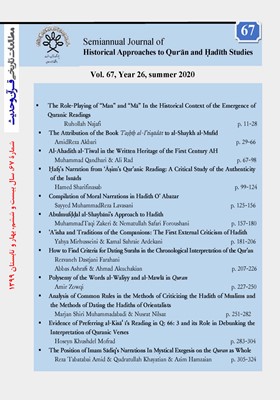-
-
List of Articles
-
Open Access Article
1 - The Role-Playing of "Man" and "Mā" In the Historical Context of the Emergence of Quranic Readings
RUHALLAH NAJAFI -
Open Access Article
2 - -
-
Open Access Article
3 - Defending the Attributing the Book “Taṣḥīḥ al-I’tiqādāt” to Sheikh Mufīd
Amidreza Akbari -
Open Access Article
4 - Al-Ahadith al-Tiwal in the Written Heritage of the First Century AH
Mohammad Ghandehari Ali Rad -
Open Access Article
5 - Ḥafṣ's Narration from ‘Āṣim's Qur’anic Reading: a Critical Study of the Authenticity of the Isnāds
Hamed Sharifinasab -
Open Access Article
6 - Compilation of Moral Narrations in Hadith O' Abazar
Seyed Mohammad Reza Lavasani -
Open Access Article
7 - Abulmufḍḍal al-Shaybāni's Approach to Hadith
mohammad taghi zakeri nemat allah safari froshani -
Open Access Article
8 - Table of contents and English Abstracts
-
Open Access Article
9 - 'A'isha and Traditions of the Companions: The First External Criticism of Hadith
yahya Mirhoseini kamal sahraei Ardakani -
Open Access Article
10 - How to find Criteria for Dating Surahs In the Chronological Interpretation of the Qur'an
رضوانه دستجانی فراهانی abbas ashrafi ahmad akoochekian -
Open Access Article
11 - Polysemy of the Words al-Waliyy and al-Mawlā in Quran
Amir Zowqi -
Open Access Article
12 - Analysis of Common Rules in the Methods of Criticizing the Hadith of Muslims and the Methods of Dating the Hadiths of Orientalists
marjan shiri nosrat nilsaz -
Open Access Article
13 - Evidence of Preferring al-Kisāʼī’s Reading in Q: 66: 3 and its Role in Debunking the Interpretation of Quranic Verses
حسین خوشدل مفرد -
Open Access Article
14 - The Position of Imam Sādiq’s Narrations In Mystical Exegesis on the Quran as Whole
Reza Tabatabaee Amid Ghodratollah Khayyatian Azim Hamzeian
-
The rights to this website are owned by the Raimag Press Management System.
Copyright © 2021-2025







